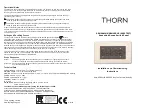
8. Performance > Congestion Detection and Management
196
Tsi578 User Manual
June 6, 2016
Integrated Device Technology
www.idt.com
8.4.3.2
Multicast Throughput
The maximum input payload bandwidth of the multicast engine is 10 Gbit/s. This corresponds to a line
rate of 4x mode, 3.125 Gbaud at the ingress port. The maximum input bandwidth of the multicast
engine can be sourced from one ingress port or multiple ingress ports.
When there is no congestion, and when all destination egress ports have a line rate of 4x mode
(3.125 Gbaud) the egress port always maintains the line rate. There is no bubble-packet in the egress
packet streams except for the idle sequence insertion every 5000 code-groups required by the
RapidIO
Interconnect Specification (Revision 1.3)
. There is also no retry at the ingress port because the ingress
aggregation is handled by the multicast arbitration. This is true for any payload size and different
priorities.
When any of the egress port has a line rate lower than the input bandwidth of the multicast engine,
retries occur at the ingress port. In this situation, the egress port maintains its line rate.For example,
when an egress port is set to 4x mode, 2.5 Gbaud while the multicast engine is receiving a single or
aggregated input data at maximum 10Gbit/s, retries happen at the ingress port(s). However, the egress
port still maintains its line rate with no bubble inserted in that packet stream.
8.5
Congestion Detection and Management
The congestion detection and management functionality enables the system management host to
monitor the system through a series of registers. The system host can monitor the ingress and egress
queue levels and the frequency at which the queues are above the threshold defined by the DEPTH
parameter. The behavior and effects of the various tick timers and counters is described in the flow
chart shown in
.
Table 25: 4x/1x Multicast Latency Numbers Under No Congestion
Reference Clock
Ingress and Egress
Port Width
Ingress and Egress
Baud Rate (Gbaud)
Minimum Latency (ns)
a
a.
Due to the asynchronous ability of the clock frequencies within the device, the latency numbers can vary as
much as 6.4 ns.
156.25MHz
4x
3.125
163.2
2.5
178.4
1.25
254.4
1x
3.125
188.8
2.5
210.4
1.25
318.4
















































